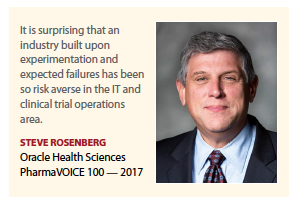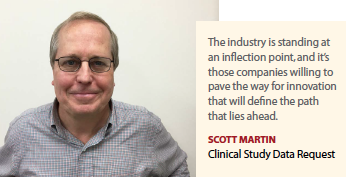Although the pharma industry scored pretty low on a McKinsey scale of digital maturity, there is evidence that it is moving — perhaps only incrementally — toward a digital transformation that can streamline processes, generate collaboration, and coordinate data collection.
The pharma sector, not surprisingly, is also lagging behind other industries in digital performance. According to McKinsey, only 10% of pharma companies polled as part of its study said they are basing their strategic decisions on a clear understanding of how digital impacts their business. The upside: one in five of the top pharmaceutical companies has created a chief digital officer position or equivalent.
The McKinsey’s Digital Quotient assessment tool measures digital maturity across four categories — strategy, culture, organization, and capabilities — and 18 management practices ranging from  agility and customer focus to governance and connectivity. Using a 100-point scale, the pharma industry’s score of 27 lags behind the average of 33 across all sectors. It even trails other highly regulated businesses, such as banking at 32 and insurance at 31.
agility and customer focus to governance and connectivity. Using a 100-point scale, the pharma industry’s score of 27 lags behind the average of 33 across all sectors. It even trails other highly regulated businesses, such as banking at 32 and insurance at 31.
Despite this less than average grade in digital maturity, some life-sciences companies have already taken steps toward a technological transformation in the areas of clinical operations, regulatory information management, pharmacovigilance, R&D, marketing, sales, operations and finance, IT, and even human resources. Several of the largest pharmaceutical companies that are embracing the use of digital, according to our experts, include Sanofi, Merck, J&J, Novartis, and GlaxoSmithKline, to name a few.
Our experts remain optimistic about an impending transformation, because frankly, most agree it will be the only way for the industry to survive.
“Biopharma companies are transforming the way they do business to meet the challenges of a more complex operating, regulatory, and reimbursement environment," says Alistair Macdonald, CEO of Syneos Health.
 Sharon Callahan, CEO of TBWA\WorldHealth, adds the industry can’t keep doing things the way it has always done them, and we’re starting to see some transformational moments. “The industry will continue to transform, because if it doesn’t, companies are not going to be able to survive," she says.
Sharon Callahan, CEO of TBWA\WorldHealth, adds the industry can’t keep doing things the way it has always done them, and we’re starting to see some transformational moments. “The industry will continue to transform, because if it doesn’t, companies are not going to be able to survive," she says.
One of the major pressures facing the industry is the rising cost of research and development, as well as the changing healthcare ecosystem that has patients and payers more focused on cost and value than ever before.
“The rising cost of R&D is a much bigger challenge than ever before," says Evi Cohen, VP, global pharma and life sciences industry lead, Appian. “Today it takes about $2.6 billion to develop a product. This number is expected to increase to more than $25 billion by 2020. This is clearly unsustainable."
A new world transformation would embody eliminating silos and gaining a broad, end-to-end vision into operations at any given time. A large company today, such as Merck, has to manage and coordinate operations across about 69,000 employees spread over more than 140 countries.
Digital tools can enable a more coordinated and aligned business process while the core mission of the industry stays the same: creating life-saving drugs faster and getting them to market quicker.
Mr. Cohen says healthcare mega-collaborations, such as Amazon, Berkshire Hathaway, and JP Morgan, are instrumental in driving the charge to industry evolution.
“Realism is setting in and while we may see a slower adoption than we would like, transformation will happen," Mr. Cohen says. “Partnerships such as the Berkshire Hathaway, Amazon, and JP  Morgan collaboration to establish a solution in the healthcare space will continue to influence the environment, and we’d better be ready."
Morgan collaboration to establish a solution in the healthcare space will continue to influence the environment, and we’d better be ready."
Ms. Callahan says most of the transformational changes in pharma at this point have been incremental, and this approach to taking baby-steps could be the industry’s downfall. She also notes that external disruption is starting to drive momentum.
“Pharma is used to moving incrementally, but it needs to embrace a bigger vision and start moving exponentially," she says. “The future is going to come at us very, very quickly and we need to simplify our very complicated processes and start to prioritize differently to meet that future."
Several thought leaders have compared the industry’s status with that of the frog-in- a-pot metaphor, the premise being that if a frog is put suddenly into boiling water, it will jump out, but if the frog is put in tepid water, which is then brought to a boil slowly, it will not perceive the danger and will be cooked to death.
“This change has been occurring for years, but, like the frog in the simmering water, this change has not been abrupt, so the reaction from the industry has been gradual," says Andrew Schirmer, CEO at Ogilvy CommonHealth North America. “But the future is now and many manufacturers and agencies are already embracing this reality."
As in other industries, pharma leaders have learned firsthand that the command-and-control approach to business no longer applies to an always-on, hyper-connected, rapidly changing and increasingly digital world.
According to Mr. Schirmer, in an innovative move, some of the players in the biopharma space have embraced the hack mentality associated with Silicon Valley, which brings multi-discipline, diverse, and curious players together with clear direction and motivation to rapidly diagnose, discuss, debate, and create while constantly challenging and iterating along the way.
“Prototype thinking applies to all aspects of innovation and creativity in this brave new world, and it allows participants to build in the risk analysis throughout the design process instead of at the very end or the output stage of the process," Mr. Schirmer says.
Mr. Cohen expects the industry will start buying technology companies so that they can bring those capabilities in-house. He notes this is already happening in the CRO space, citing the example of  the creation of IQVIA, the combining of IMS Health, Quintiles, and DrugDev. “Part of the reasoning behind the merger and acquisitions was to gain access to patients and physicians, but the strategy was also driven by the need to gain access to the technology," he says. “Eventually, pharma companies will become life-science technology companies."
the creation of IQVIA, the combining of IMS Health, Quintiles, and DrugDev. “Part of the reasoning behind the merger and acquisitions was to gain access to patients and physicians, but the strategy was also driven by the need to gain access to the technology," he says. “Eventually, pharma companies will become life-science technology companies."
According to Patrick Lindsay, president and CEO at UBC, as the technology industry improves consumer access to its own healthcare information, it will also find new and innovative ways to enable consumers to make choices on how they order, pay, and receive therapies. This will drive forward a change in patient care for which the pharma industry must be ready.
For example, Apple announced that with iOS 11.3 patients aligned to 12 national healthcare systems can have access to their clinical card documents directly on their phone, opening the door for innovative follow-on applications to improve patient care and caregiver connectivity.
“Technology powerhouses know that scale matters, and they are pushing in that direction today  with cloud computing services, artificial intelligence, and data collection devices," Mr. Lindsay says. “Scale also matters for where and how life-sciences organizations will meet consumers."
with cloud computing services, artificial intelligence, and data collection devices," Mr. Lindsay says. “Scale also matters for where and how life-sciences organizations will meet consumers."
For example, imagine a voice recognition assistant in the healthcare setting — for example Amazon’s Alexa becomes a nurse. These platforms will use artificial intelligence to not only populate medical records, but trove through massive cloud-based data sets in real time to provide guidance for the path of therapy.
Former Google Chairman and CEO Eric Schmidt called out this example at HIMSS 2018 as a use case that he is confident will exist in a few years. Mr. Lindsay believes this example means that life-sciences organizations will have to adopt their real-world evidence practices to account for changes in data collection, new regulations in data privacy, and algorithm development.
While many are quick to name tech companies such as Google, Apple, and Amazon as disrupters of the healthcare industry, John Nosta, president of NostaLab, says there is still plenty of innovation happening within the traditionally defined life-sciences arena.
“At the heart of this whole era of exponential change and innovation, we still have to recognize that pharmaceutical companies are a bastion of innovation that are living in the context of profound societal and global change, and that it’s going to be a long journey," Mr. Nosta says. “We shouldn’t demean the genius of the pharmaceutical industry by assuming Google and Amazon are the only companies that are disrupting the industry. The real disruption is still coming from the pharmaceutical industry in the form of immuno-oncology and CRISPR, for example."
Mr. Nosta says he is also not very confident that pharma’s transformational future is going to live  up to the hype. He believes pharma will keep being pharma, and continue to do business just as it always has, but only now it will do business using more technology.
up to the hype. He believes pharma will keep being pharma, and continue to do business just as it always has, but only now it will do business using more technology.
And even though patients, data analytics, and artificial intelligence will all play a role, the essential core of pharma will still be focused on the management of a clinical development pipeline around a disease category.
“From a 30,000-foot perspective, we will have new tools of discovery, of analysis, and of engagement, but they will not destroy the business the model; they will enhance it."
He cites the example of the dawn of the computer age: prior to computers, pharma used to do everything on paper. Now processes are electronic, but the industry did not fundamentally change its mission during this transition, which is being in the business to develop treatments. “Pharma does not want to become Apple and Apple does not want to become pharma," Mr. Nosta believes. “The domain of the life-sciences industry is and always will be around the notion of discovery."
Steve Rosenberg, general manager and senior VP, Oracle Health Sciences, believes that tech disrupters will have a profound impact on healthcare, as more knowledge and power are handed to the patients, but he doesn’t expect them to be major players in the disruption of clinical research.
 “People will want their healthcare the same way they order Uber or pay people on demand and on their own terms; this is where these tech disrupters will play a part," Mr. Rosenberg says.
“People will want their healthcare the same way they order Uber or pay people on demand and on their own terms; this is where these tech disrupters will play a part," Mr. Rosenberg says.
Technology, itself, holds big promise for pharma, in terms of understanding not only data, but also science, Mr. Nosta adds.
“Technology can be applied No. 1 to understand data in a bigger and broader way, and No. 2 to understand science and biology as we begin to better understand the genome, for example, or other complex physiologic activities or disease processes," he says.
Clinical drug development programs will similarly benefit as technology will improve the ability to screen molecules and to look at molecules in the context of a genomic parameter and not just a large population-based cohort, which will allow the industry to bring medicines to market that once failed for unique indications, he says.
Mr. Nosta also adds that the way disease is treated will change, which will provide rich therapeutic business opportunities for the pharmaceutical industry. For example, clinical science will eventually get to the point of stage zero medicine, which means finding disease earlier and earlier. For instance, eventually researchers will be able to identify markers of early-stage subclinical cancer that can be measured with a nanoparticle or a dipstick urine test.
“We will move along the continuum from treating disease to early detection and early engagement to manage that disease and stop a disease before it becomes systemically toxic," he says. “And by treating disease at the earliest possible point, this in essence borders on prevention, and that’s a very interesting dynamic. We often think the best way to prevent disease is to stay healthy, be active, eat green leafy vegetables. But I’m suggesting that the best way to prevent disease is technologically empowered early disease prevention and disease management."
Another consequence of a techno-driven transformation is that pharma’s value stories are now being driven by access to outcomes research and data insights, says Tina Moen, Pharm.D., deputy chief health officer, IBM Watson Health. If pharma companies can more effectively tap into their proprietary product and patient safety data and combine this intelligence with real-world evidence, they will have a better understanding of the impact that their products have on patients, which will give them the ability to better position themselves in the market. Technology solutions that leverage advanced analytics and artificial intelligence can enable pharmaceutical companies, payers, and providers to make sense of and gain insight from the combination of publicly available data as well as their own proprietary data.
Collaboration is Key to Transformation
Perhaps the greatest asset to come out of the transformational period in pharma is the idea of collaboration.
 Every thought leader we spoke to mentioned it as being one of the tools to survival in the coming years.
Every thought leader we spoke to mentioned it as being one of the tools to survival in the coming years.
Partnerships can help increase speed to market, generate new ideas from outside sources, or to turn vast amounts of big data into valuable data. A historically insular industry, pharma in the future will require companies to rely on others with different skillsets to mind its gaps.
“No one company is going to solve the biggest challenges in life sciences and healthcare; collaboration with organizations and subject matter experts across disciplines will be key," Dr. Moen says. “The whole ecosystem would benefit if there were more collaboration."
IBM Watson Health is actively taking part in collaborating with pharmaceutical companies and has witnessed a positive impact throughout the industry. “For instance, we’re partnering with Celgene and other life-science companies to enhance pharmacovigilance methods, which is currently a largely manual, time intensive process. By co-developing a new solution, Watson for Patient Safety, that uses analytics and AI to improve drug safety monitoring practices, Celgene will be able to automate this cumbersome process."
While pharma companies face some unique challenges in partnering with peers due to intellectual property protections and antitrust regulations these limitations are not insurmountable.
According to Mr. Lindsay at UBC, the industry has moved beyond the initial phases of “will it collaborate" to discussion on “how to collaborate."
“There are strategic discussions happening internally within pharma related to which companies to partner with, how much risk/reliance will they place on those decisions, and how will the strategic alignment benefit all of the parties involved," he says. “Other discussions include how clinical  development strategies, medical and scientific affairs approaches, physician and patient communications, and managed markets and trade decisions will change when some of the mid- and longer-term operational, financial, and strategic road map items exist outside of a company’s four walls."
development strategies, medical and scientific affairs approaches, physician and patient communications, and managed markets and trade decisions will change when some of the mid- and longer-term operational, financial, and strategic road map items exist outside of a company’s four walls."
A recent example of a multi-pronged collaboration for online patient-level clinical trial data open to researchers involved Clinical Study Data Request (CSDR) and four major nonprofit partners: The Bill & Melinda Gates Foundation, Cancer Research UK, the Medical Research Council, and Wellcome Trust. The new consortium partners expand CSDR’s ability to deliver upon its mission to help generate valuable research results. CSDR houses clinical trial data from 14 of the world’s leading pharmaceutical companies across multiple therapeutic areas.
This type of data is changing the face of science and medicine where collaboration is key, says Scott Martin, chair of the Clinical CSDR steering committee.
“In today’s Information Age, healthcare and technology have become closely linked, with data serving as a catalyst for advancements from bench to bedside," Mr. Martin says. “That’s why businesses must consider novel partnership opportunities, just as CSDR has done by bringing together collaborators that are united behind a common mission of sharing data that can help researchers generate meaningful results for patients."
Collaborations cut across almost every parameter of innovation in the world today and its primary function is speed. The change in medicine that lends itself to collaboration is exponential medicine, Mr. Nosta says. And the speed at which the change is taking place is exponential change.
“Speed to market, speed of learning, speed of influence are extraordinary today," he says. “There are whole schools of thought built around the rapid change in technology, science, and medicine. “
As these changes occur, companies need to structure an innovation scenario that incorporates collaboration to help fit or live within this dynamic, which Mr. Nosta calls the “collaboratory."
In a “collaboratory" environment, companies do not own the entire end-to-end process of innovation. Of the three pillars of innovation — the idea, the evaluation of the idea, and bringing the idea to market — the idea may actually come from outside the conventional pharmaceutical industry. It is the other two principles of innovation that pharma will play a role in — the clinical evaluation and market access.
“Pharma is realizing that it competes on molecules and science and not on CRF design," Mr. Rosenberg says.
Consortiums such as TransCelerate, the nonprofit organization whose mission is to collaborate across the global biopharmaceutical research and development community to drive more efficient and effective delivery of new medicine, have paved the way for the industry.
When Novartis joined TransCelerate as the 19th biopharma company to come on board, Badhri Srinivasan, head, global development operations at Novartis and member of the TransCelerate board of directors, said in a company press release: “Over the last few years, we have observed TransCelerate making significant progress on tackling opportunities within research and development, Novartis has been at the forefront of improving drug development efficiency, and by joining TransCelerate, we can both contribute to and benefit from the collaborative power of this industry-wide organization."
Mr. Lindsay expects once the industry sees the power of collaboration, it will become even bolder and hence more exploratory on new business models that extend beyond their own organizations.
“There are plenty of partnerships among pharma, biotech, and diagnostics organizations, laboratory and imaging providers, pharma and data providers, pharma and clinical centers of excellence, joint ventures with rigorous milestones that impact — favorably or unfavorably — both parties," Mr. Lindsay says. “In the future, we will see more partnerships blossom between manufacturers and governments with manufacturers getting closer to payers and data sharing agreements."
Further, he says, as the agencies within HHS, (FDA, ONC, CMS, etc.) all set their agendas to ensure productivity in key disease and commercial capacities to ensure advancement within a variety of specialty disease areas it is essential to implement facilitated pathways to allow this to occur while developing new pricing approaches that will drive better decision making and access to affordable care. If these agendas are not robust enough the market will recognize that small incremental advances will not drive reciprocal value fast enough.
And collaboration will be key within the organizations, as well, as silos will become a thing of the past.
“The age of the silo is over," Mr. Schirmer says. “Within all companies involved in the healthcare and life-sciences space, there has to be a new view of horizontality that calls for a systems-based approach focused on solving real problems, improving and in some case saving lives, and helping to create a better world."
R&D will no longer be able to work in isolation from commercialization, communications, and finance. Those working in the clinical space need to have a broader view of the environment surrounding the patient, and the health outcome teams need to have a clear sense of healthcare, patient, and often caregiver needs, Mr. Schirmer says.
On the agency side, teams need to be able to provide clients with a full view of a category landscape, marketplace opportunity, and stakeholder insight while providing every aspect of engagement, messaging, and measurement in a seamless fashion. Connectivity and collaboration are critical elements of this new construct.
“The winners in this new market will be biopharma companies and solution partners that make collaborating across disciplines — just not working in clinical or commercial silos — the standard model to solving complex problems," Mr. Macdonald says. “And, the entire team at all levels needs to have deep therapeutic expertise, a data-driven operating philosophy, and familiarity and facility with digital channels and emerging technologies."
Pharmaceutical organizations have no choice but to have a stronger digital focus; it’s how humans find data and communicate, says John Cassimatis, co-founder and president of TayganPoint Consulting Group.
“Organizations have to meet the patient where they are online," he says. “Today, digital HITS is the score keeper of success. We are seeing organizations implement more enterprise-wide technology platforms rather than in functional silos. These new operating models and technologies enable companies to be more agile and flexible to take advantage of new marketplace opportunities." (PV)
~~~~~~~~~~~~~~~~~~~~~~~~~
Transformation from the Solutions Provider Perspective
Executives from solutions providers provide their perspectives on how prepared the industry is for a transformation in the clinical-trial environment.
James Corrigan
President and CEO, ERT
The life-sciences companies that are best prepared and will benefit the most from the inevitable transformational opportunities coming our way are those that are already adopting fresh approaches to drug/device development, specifically in how they design and manage clinical trials. Those companies that take a strategic view of what it takes to make clinical trials more successful — and more efficient — are now looking at more than just research methods. They’re also examining the surrounding technologies and processes that enable real-time performance and risk management, support greater stakeholder collaboration, and deliver more accurate data.
Chris Evans
VP, Global Innovation, West Pharmaceutical Services Inc.
Data continue to show that adherence is a challenge. This has forced a shift from treatment-centricity to patient-centricity, with a growing focus on the improved use of data and technology to understand and proactively address patients’ needs. Human factors analysis employed early in the development of injectable drug delivery systems, for example, can enable manufacturers to create self-administration technologies that patients can and will use. Providing multisensory training can also reduce the potential for errors and anxiety.
Lastly, leveraging electronically connected drug delivery systems to educate and engage patients in their care can help increase medical literacy and reward compliance. This holistic, data-driven view of the patient journey is critical to ensure we’re not just thinking about treatment, but how to improve patient outcomes.
Chitra Lele, Ph.D.
Chief Scientific Officer,
Sciformix Corp.
PharmaVOICE 100 — 2014
Collaboration between all stakeholders and encouraging proactive healthcare interventions are essential in making a meaningful impact on public health and individual well-being. Pharma companies have the opportunity to use their knowledge, expertise, and new technologies to play a bigger role in healthcare reform. Encouraging smart use of digital health technology to increase patient engagement will aid in this change. Companies need to increase focus on patient-centricity and patient participation in decision-making, through greater emphasis on capturing, analyzing, and using real-world outcomes to become providers of healthcare and wellness.
~~~~~~~~~~~~~~~~~~~~~~~~~
Study: Life-Sciences Companies Are Preparing for Large-Scale Transformation
A recent study conducted by TayganPoint Consulting Group revealed that almost 30% of pharma companies will undergo a large transformation in the next three years. Half of those companies have changed their transformational strategy in the past year — the most frequently reported reasons for the change include: more digital focus, adoption of new technology, and new organization structure due to acquisition or merger.
A changing customer landscape (patients, providers, payers); heightened focus on pricing and value; and increasing competition not only from traditional peers but from new entrants looking to disrupt the industry are driving the plans for transformation. Internally driven factors, such as the need to be more cost-effective without losing efficiency, are also driving forces behind transformation.
The other major area impacting an organization’s transformational strategy is talent, with 74% of organizations saying they are concerned about having the right talent in place to transform successfully.
Source: Taygan Point Consulting Group
~~~~~~~~~~~~~~~~~~~~~~~~~
An Industry Transformation Requires Transformational Leadership
Thought leaders discuss how skillsets across the board need to change to keep pace with an innovative pharma model — from the C-suite to the sales team.
A recent study conducted by TayganPoint Consulting Group showed 74% of companies surveyed are concerned about having the right talent in place to transform successfully.
Sharon Callahan
CEO, TBWA\WorldHealth
PharmaVOICE 100 — 2017
Traditionally pharma leaders are groomed to manage people and processes, but in today’s world, leaders need to be able to manage purpose and principles as well. Internally and externally, we’re seeing disruption; and in an industry where leaders have been making incremental changes, what we need now is exponential leadership because we need to deliver exponential results. When I say incremental, I mean that we’re a people and process industry but we’re not really focused on the future. We’re very reactive versus proactive. No one really understands what a company or brand stands for beyond just curing a disease. Right now, pharma companies have competitors instead of partners and collaborators. And they’re going to have to partner and collaborate in a much different way going forward because they can’t just be insular; companies have to be a partner and a collaborator. This mindset will be required going forward. We also talk about being patient-centric, but I don’t find a lot of empathy in the way that we approach patients or doctors, and there’s no simplicity in our approach. This is something future leaders will need to focus on.
Patrick Lindsay
President and CEO, UBC
PharmaVOICE 100 — 2007
Future leaders will need to ensure their organization has a robust, formal, “owned strategy" that addresses late-stage development and patient services as a horizontal more flat evidence development pathway, where safe use, efficacy, effectiveness, outcomes, and patient preference are of equal bearing on the filing and commercial positioning of their product.
The organization will also need a primary, secondary, and partner driven data and insights strategy to accompany late-stage clinical and commercial portfolio planning to ensure there are no gaps in data to support their ideal therapeutic product profile, as well as mapping of stakeholder value perceptions so companies are not caught flat-footed and too late in the submission or launch process. It will be important to ensure that the BD function, which is commonly pointed at therapeutic partnerships, extends to include more novel partnerships that may reside outside the company’s competencies, but is relevant to the late-stage clinical and commercialization goals.
Marketing leaders will need to allow the patient voice to help drive demand and embrace digital direct-to-consumer approaches in a new way, or in other words “meet them where they are." As content becomes more distributed, marketers will need to create a more powerful understanding of patient personas, behavioral trends, and intrinsic motivators to act and be engaged in their care. Content must be produced to inform and bring patients into the discussion, better allow services to be present where they are, and take advantage of new tools to wrap around their therapeutic experience. Marketing teams will need to move beyond product detailing and messaging and must address the entire patient-care coordination experience.
Scott Martin
Chair of the Clinical Study Data Request (CSDR) Steering
Committee
I’d say future leadership is going to need “vision." The industry is standing at an inflection point, and those leaders who pave the way to innovation will help define the path ahead.
Leadership is about embracing innovation, while remaining true to guiding principals, such as positioning patients as the driving factor for all that we do and the ethics to which we hold ourselves while driving novel discoveries that are transforming science.
Tina Moen
Pharm.D., Deputy Chief Health Officer, IBM
Watson Health
The value chain from R&D through postlaunch surveillance and marketing can continually improve with new technologies to enhance speed, consistency, quality, and insights and of course, to reduce costs. Skillsets of the individuals across the continuum must evolve to effectively capitalize on new technologies. Many industries, including healthcare, are being reshaped by data science and cloud computing. In addition, needs for other tech-based skills are creating a crop of new positions. At IBM, we call these “new collar" jobs — or jobs that may not require a traditional four-year degree, but do require a specific skillset.
Technologies enabled by AI empower humans to do more with their time and resources and to make more informed decisions. To most effectively leverage AI technologies, organizations must ensure their workforces are prepared and adequately trained to integrate AI into their workflow. AI can help companies become more agile and rapidly develop and deploy new innovations by capitalizing on the wealth of knowledge in their data stores. The key is finding the right balance and understanding the potential and limitations of AI and knowing where in the workflow AI technology provides the greatest impact. Technology should never make decisions, but rather it should augment a team’s expertise.
In the C-suite, pharma executives who understand the potential of AI and data-driven technologies to accelerate innovation and how it can enable better patient care and advance discoveries will be better positioned to lead their organizations to success.
Ultimately, an executive team that can adapt to disruptive technology changes in the industry and assemble a team of experts who can master the skill of applying advanced analytics and AI technologies on top of a robust data strategy will lead the organization to insights that will drive commercial success.
Steve Rosenberg
General Manager and Senior VP, Oracle Health Sciences
PharmaVOICE 100 — 2017
It has always surprised me that an industry built upon experimentation and the obvious failures that are part of that has been so risk averse in the IT area and the clinical trial operations area. We are seeing this start to change with the formation of innovation groups across the industry. But the big changes will require senior leadership commitment and the ability to lead through that change from both a business and IT perspective.
Many people within pharmaceutical companies will feel threatened by these changes and it is up to the C-suite to lead them through it.
Andrew Schirmer
CEO, Ogilvy CommonHealth North America
Leaders need to provide clarity and purpose as this industry continues to evolve and get more complex. More information doesn’t always mean more knowledge, and so the leaders of today must have a deep enough understanding of specific areas of focus that they are able to ask the right questions across all areas of the business. Leaders will have to push against existing dogma and surround themselves with a hyper-diverse set of experts across a range of specialties and skill sets. As people inside organizations struggle to keep up with the onslaught of information, data, and of course a fair amount of noise, they need leaders who are able to articulate a clear vision, inspire innovation and risk taking, and define the purpose of the enterprise at the highest and most meaningful levels. In the biopharma industry and broader healthcare industry, there is also the opportunity to connect the product offering and business objectives with broader societal needs.
The fact that study after study show millennials are more apt to support companies and brands that align with their own personal beliefs of what makes a good corporate citizen is something that this industry needs to be aware of and be prepared for. While much of the discussion over the last decade or so has been about outcomes-based valuation of medicine, there is a growing trend of companies showing their value as global citizens.
Ben Wiegand, Ph.D.
Global Head, World Without Disease
Accelerator,
Janssen Pharmaceutical Companies of Johnson & Johnson
PharmaVOICE 100 — 2018
Transformation will require an entrepreneurial mindset, with leaders who think differently, take risks, and disrupt the status quo. Teams need to see the bigger picture, they need to be inspired, and they need to be encouraged to innovate. Transparency and authenticity are necessary to build trust. Shifting an industry paradigm will not happen overnight, therefore leaders need to be disciplined. They need to develop a focused plan of action with defined goals, objectives, and priorities to advance the long-term vision. Transformation requires leaders to engage and inspire stakeholders to join the journey. Cross-functional collaboration — internal and external and across sectors — is essential to affect change on the entire industry ecosystem.
Wendy White
Chief Patient Advocate, Vitrisa
Therapeutics Inc.
PharmaVOICE Red Jacket — 2017
People skills will be especially important. Leaders will need to inspire through purpose, create a culture of continuous learning, be active listeners, advocate for inclusion, and adopt a collaborative mindset.


















